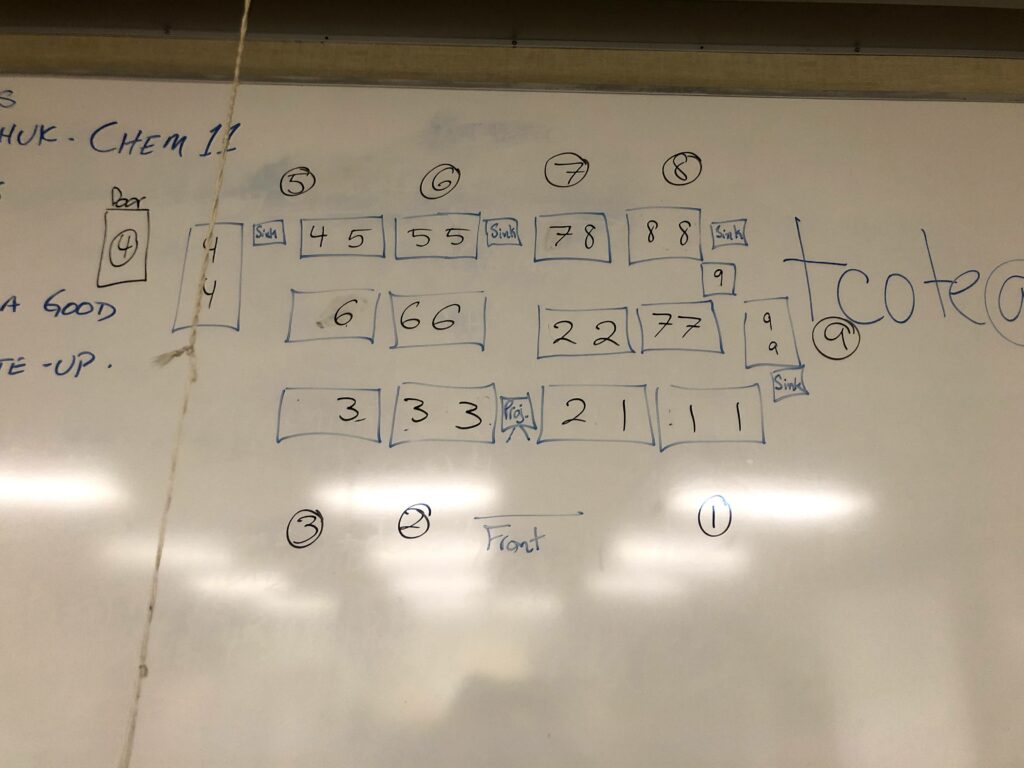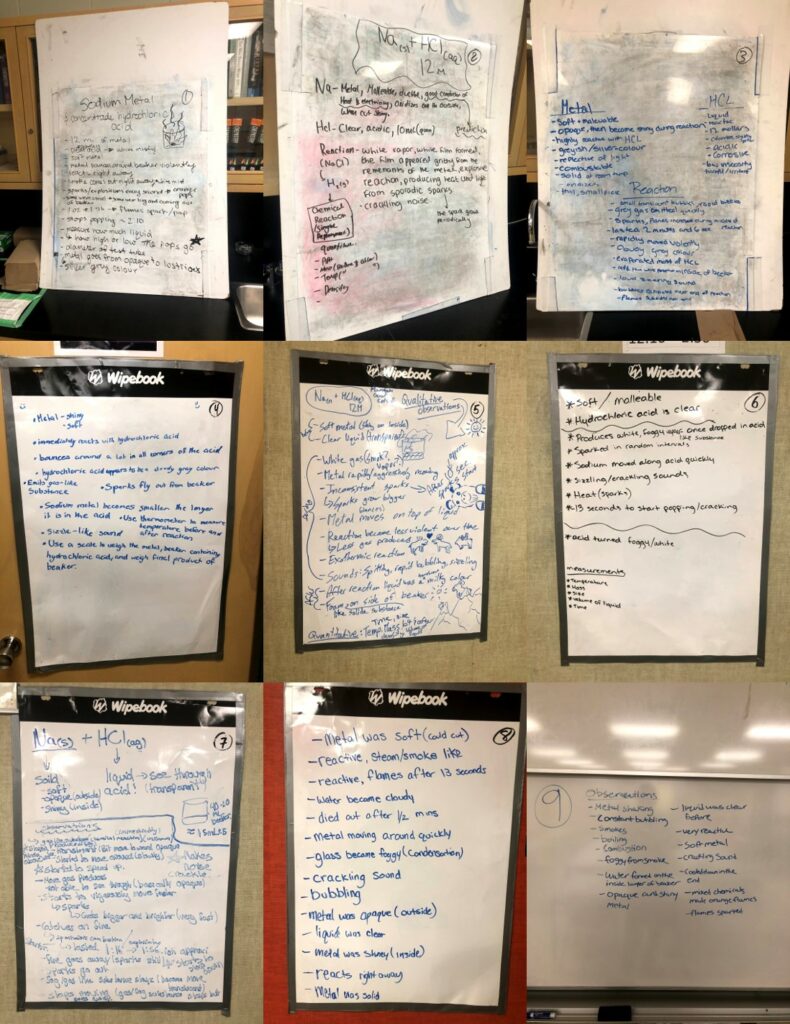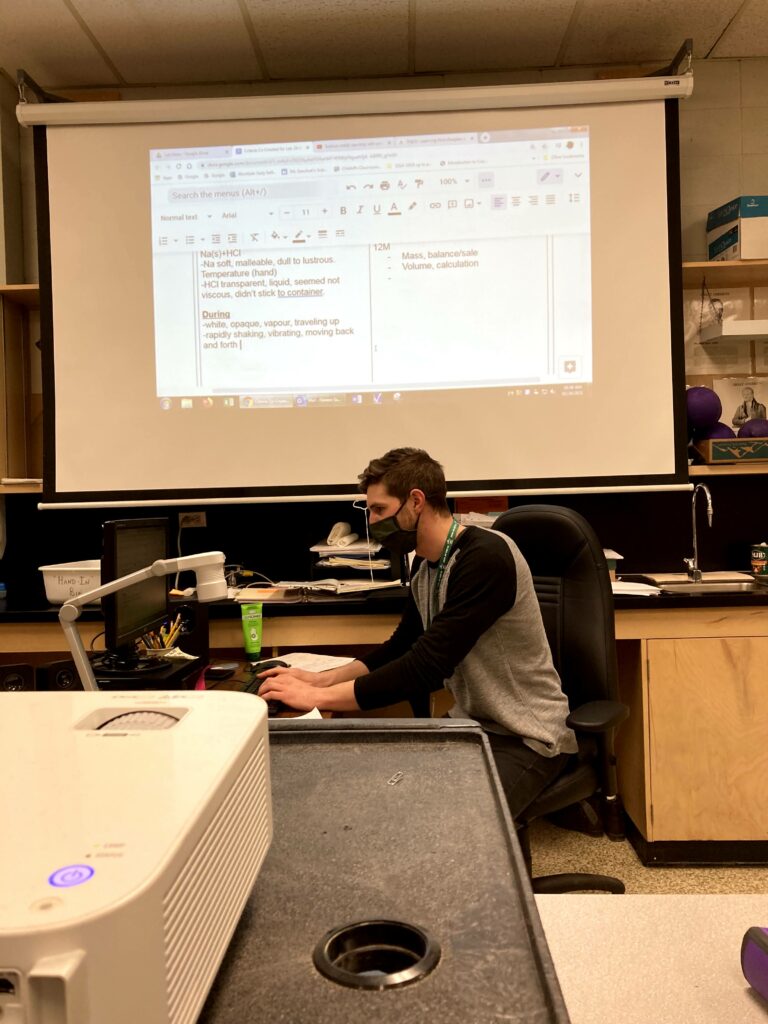Educators implement effective planning, instruction, assessment and reporting practices to create respectful, inclusive environments for student learning and development.
Standard 5 and and Observation Lab
During the first week of Experiential Practicum 391, the students and I co-created criteria for a lab that concentrated on making Grade 11 scientific observations of chemical reactions. After completing the lab, the students then peer-assessed another student’s lab in the class and used their peer-assessment to refine their work before handing it in. The entire process took three days to complete. This process robustly satisfied Education Standard 5 as outlined below:
Day 1: Co-Creation of Criteria
Planning: During the actual laboratory experiment conducted the following day, the primary observations students made were focused on what happened when certain metals were put in solutions (i.e. Calcium metal in water). In order co-create criterion before conducting the lab, the reaction between sodium metal and hydrochloric acid, shown in the YouTube video below, was selected as a specifically relevant model to make observations and create criterion from.
During the planning process, my CT (DS) and I developed an assessment rubric based on the targeted curricular competencies (listed below) under the Chemistry 11 Curriculum. Additionally, students had just completed their measurement unit which focused on appropriate use of equipment and measurement, including SI units and sig. figs. Therefore, their summative proficiency under the relevant subheading of Planning and Conducting could be improved during their lab. On the third day, students were asked to peer-assess a classmate’s laboratory write up which was focused on the Evaluating curricular competency. A summative assessment rubric was also created for their peer-assessments. Prior to implementing this lesson, I made my own criteria-based observations of the video, formed guidelines for creating criteria, and made note of specific observations to focus on in class.
Targeted Curricular Competencies:
Planning and conducting:
- Collaboratively and individually plan, select, and use appropriate investigation methods, including field work and lab experiments, to collect reliable data (qualitative and quantitative)
- Use appropriate SI units and appropriate equipment, including digital technologies, to systematically and accurately collect and record data.
- Qualitative observations need to be accurate (true) and precise (using descriptors)
Communicating:
- Communicate scientific ideas and information, and perhaps a suggested course of action, for a specific purpose and audience, constructing evidence-based arguments and using appropriate scientific language, conventions, and representations.
Evaluating:
- Describe specific ways to improve their investigation methods and the quality of their data
Instruction and Co-Creation of Criterion:
In order to clearly define what a grade-level scientific observation entailed, I had students make observations based on the Na + HCl reaction shown above by playing the video clip several times on the projector screen. Before making observations, we clearly discussed relevant concepts including:
- observations vs inferences (see Fig. 1)
- accuracy vs precision
- qualitative vs quantitative observations
- chemical vs physical properties
- observations over time
- scientific equipment and human senses

Observations made from the video were refined over three segments: individual observations, group observations, and class observations (from which criterion was derived). During the first segment, students were asked to individually record any and all pertinent observations they saw or heard during the video clip on a piece of paper(which was iterated a few times).

During the second segment, I had students collaborate in preorganized groups of three at nine vertical whiteboards which were located circumferentially around the classroom. Groups were predetermined because of COVID grouping restrictions (Fig. 2). In their groups, students discussed their individual observations made during the first segment and used the whiteboards to record and summarize their decidedly “best” observations of the group (Fig. 3). During this process, I was able to circulate to each group and make formative assessments based on their observations and group participation while providing feedback and assistance centered around the concepts we had discussed (recall list above). This process allowed me to really engage with the frames and levels of thinking in each group and help them refine their understanding and thinking process.

The third and final segment of Day 1 constituted the co-creation of criteria. During this segment, the students returned to their desks and as a collective, we discussed the group observations from the whiteboards and collaboratively decided on which observations were the best and discussed why. As this process proceeded, I wrote down the top class observations in a visibly projected document on the computer (Fig. 5).

After recording the class set of good observations, we used them to co-create criteria based on the concepts applied during the formation of the observations (Fig. 4). The class observations and co-created criteria that we made was printed and provided to the students prior to conducting their lab the following day.

Day 2: The Observations Lab
Prior to beginning this lab, the collaborative document containing both the class observations and the co-created criteria for proficiency was printed out and provided to each student. A downloadable copy of this document is included directly below. Once the lab was completed, students were given a lab write up handout to complete prior to the start of the following class.
Day 3: Peer-Assessment
At the start of class, students handed their completed lab reports to another student that was not their lab partner to be peer-assessed. The peer-assessment was to be conducted on the observations alone and required students to make their assessments based on the class co-created criteria. My CT and I had discussed and created the peer-assessment criteria for students and had them printed on a handout that they would fill in and staple to the assessed worked. Prior to handing in their lab reports, students were asked to take their peer-assessed work and make any changes or corrections to their lab reports before handing them in for summative assessment the following day. Their peer-assessment was summatively assessed as well.
| Evaluating – critically analyze the validity of information Your lab write ups are to be completed prior to class tomorrow (tomorrow is Friday February 26, 2021). You will be exchanging your labs with a student peer and perform a Peer-Assessment on their labs following the criteria we created. The criteria below outlines an appropriate and proficient Peer-Assessment. BE KIND You will be exchanging your lab with a different group. You will be looking at each other’s labs and provide clear feedback of what is done well in the lab write up (glowing) with regard to the criteria we discussed above. You will also be making some suggestions about areas of improvement (growing). Do NOT tell them what to say or what to write but DO make suggestions about areas that could be improved (eg. more precision in qualitative observations of bubbles. Watch full sentences. etc.) You will be assessed on your ability to recognize good things about a lab and to give good, clear, suggestions without “telling” what to say. (descriptive, not prescriptive) Eg. Glowing – “you used the word blue” (mmmmm this isn’t something to be excited about necessarily.) This type of evaluation is a POOR evaluation. Note: You will be given a chance to improve your lab based upon your classmates’ feedback. Your lab should be better due to this feedback. |
Final Thoughts and Assessment:
This lesson clearly demonstrates Standard 5. The planning and instruction described above only touches the surface of the dynamic learning that occurred during these three days. The entire process was highly inclusive because it offered students an opportunity to contribute and participate in many different ways and forms. For example, students who were uncomfortable participating in groups still made individual observations and observed how the criteria was created. Furthermore, the observations made and criteria created was utilized the following day through actively conducting the experiments and applying the learning from the previous day. The final day allowed students to reference the work of their peers with a critical mind and make recommendations with the goal of improvement for both their peers and themselves. Their final lab reports containing their observations and their peer-assessments were summatively assessed on a 4-point proficiency scale (Beginning-Developing-Proficient-Extending) shown below (Table 2).
| Criteria What good looks like |
| Planning and Conducting Qualitative observations need to be accurate (true) and precise (using descriptors) Qualitative observations need to be accurate (valid measurement) and precise (appropriate sig figs) Lab includes a variety of different properties observed (what human senses can be used, what instruments can be used?) Lab includes observations of changes over time (initial condition of experiment, what happened during, final observations) The observations taken are true observations and not inferences (there is no predicting or assuming what happened). |
| Communicating: Use of proper scientific ideas and terminology (units, uncertainty, proper name of equipment, proper use of words eg. gas versus air). Communication needs to be specific and clear (there was no change during the time zinc was in the water versus there was no change in 1). |
| Evaluation BE KIND Feedback provided is specific to an observation and addresses: accuracy or precision observation or inference “Glowing” describes a specific section of the lab “I noticed…” “Growing” is descriptive, not prescriptive. Eg. “you should use more description when describing the bubbles” versus “you should write that the bubbles were vigorous, aggressive and plentiful” |
Finally, I will mention that during their summative unit test, students had to make observations based on the exact criteria created in this lesson. They were provided with a looping reaction video that was very similar to both the original video used and the laboratory experiment they conducted. With every student, a clear improvement was recorded following assessment. Assessments were translated from the proficiency scale to a percent grade and reported on interim report cards.